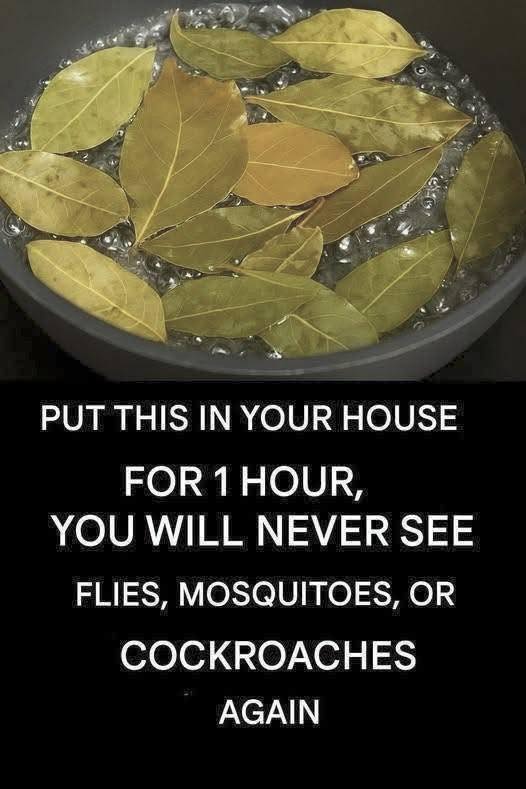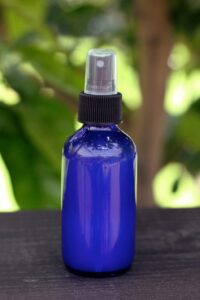Say goodbye to flies, mosquitoes and cockroaches boiling these leaves

We’ve all dealt with the buzzing, biting, and sneaky scuttling of flies, mosquitoes, and even cockroaches in our homes. Not only are they annoying, but they can also carry harmful diseases—and that’s something no one wants around their family or food.
Fortunately, there’s a simple, natural way to repel these unwelcome guests using ingredients you likely already have in your kitchen.
What You’ll Need
Ingredient Amount
Sugar 5 tablespoons
Baking powder 1 tablespoon
Water 1 cup
Bay leaves 15
Cloves (whole) 10
Plastic bottle 1 (2-liter)
Regular shampoo ½ cup
Vegetable oil ½ cup
White vinegar ½ cup
Three Effective DIY Remedies
1️⃣ Mosquito Trap
Dissolve sugar in a cup of hot water.
Stir in a tablespoon of baking powder.
Cut the top off a 2-liter plastic bottle and pour in the mixture.
Invert the top to create a funnel and place it back inside the bottle.
Set the trap in mosquito-prone areas—near windows or outdoor spaces.
2️⃣ Cockroach & Fly Repellent
Boil bay leaves and cloves in 1 cup of water for 10 minutes.
Allow to cool, strain, and pour into a spray bottle.
Spray in common insect hotspots—pantries, behind appliances, and bathroom corners.
3️⃣ Multi-Purpose Repellent Spray
Mix shampoo, vegetable oil, and vinegar in a bowl.
Stir well and transfer to a spray bottle.
Use generously in areas affected by flies, mosquitoes, or roaches.
Why These Natural Remedies Work
Safe & chemical-free: Avoid harsh store-bought repellents with eco-friendly solutions.
Easy to make: Simple ingredients, big results—no extra shopping needed.
Budget-conscious: Save on pest control with powerful kitchen staples.
Preventive: Regular use deters future infestations when paired with good cleaning habits.
Helpful Reminders
These DIY remedies can make a big difference—but don’t skip core practices like:
Keeping surfaces clean
Disposing of trash promptly
Avoiding stagnant water
Sealing food storage containers
How-to Make Homemade Essential Oil Insect Repellent Spray
There are many essential oils, known for being excellent natural insect repellents.Here are just some of them: Citronella, Clove, Lemongrass, Lemon Eucalyptus, Cedarwood, Rosemary, Tea Tree, Eucalyptus, Cedar, Catnip, Lavender, Peppermint, Basil, Rose Geranium, Cinnamon Oil, Thyme, Lemon, Orange, Pine
Many of these different essential oils work especially well for specific pests, according to the research I have done, here are some of the more well known pests and essential oils that work as repellents for them:

Mosquitos – citronella, lemon eucalyptus, peppermint, lemon, eucalyptus, catnip, basil, clove, thyme, lemongrass, geranium, lavender
Fleas – cedarwood, citronella, eucalyptus, tea tree oil, lemongrass, lavender, orange, pine,
Ticks – rose geranium, juniper, rosewood, thyme, grapefruit, oregano
Some studies have also shown, additional effective ingredients include: Neem Oil, Soybean Oil, Vodka, Garlic and Vanilla Extract
Using a 4 oz clean spray bottle, fill it with 2 ounces of distilled or boiled water. Add 1 ounce of witch hazel or vodka then about 50 to 75 drops of essential oils, any combination of the above oils should work. If you want to add more varieties of oils, just add less of each oil you are adding in, if you wish for it to be less strong of a mixture, just add less drops. You just want be sure to keep the total percentage of essential oils under 15% for safety. I added approximately .5 ounces of jojoba oil for it’s moisturizing properties, but this isn’t necessary. Remember, you don’t want to fill the bottle completely full, so there is room to shake the mixture each time, which is necessary as the essential oils do not dissolve in the water and will therefore separate.
For this first batch I went with citronella, tea tree and peppermint essential oils, as this is what I had. I had just run out of lavender, otherwise I would have absolutely added that, since I am obsessed with the smell of fresh lavender. I also would have added lemon eucalyptus oil if I had some, as several studies have shown it to be the most effective amongst all of its natural counterparts.
I have used this spray several times already and it works really, really well and it has worked well for other’s that have tried it, too.
Hope you have as good of luck with this homemade spray, as I have!
How-to Make Homemade Essential Oil Insect Repellent Spray
Makes 4 ounces
2 ounces distilled or boiled water
1.5 ounces witch hazel or vodka
30 drops citronella essential oil
25 drops peppermint essential oil
15 drops tea tree essential oil
1 teaspoon of jojoba oil* (optional, if you add this, add only 1 ounce of vodka or witch hazel
(please make sure to read above for all of the different options of oils so you can make your own custom mixture)
Using a 4 oz clean spray bottle fill with water, add the witch hazel or vodka then about 50 to 75 total drops of your various essential oils. Shake well. Spray onto exposed skin and/or clothing, avoiding eyes and mucous membranes. Reapply every 2 hours, or as needed. Store in a dark bottle, away from heat or sunlight.
**For the best results, please make sure you are using therapeutic grade oils. Please do your research if you plan to use this on a pregnant woman, young children or someone undergoing holistic treatments, as essential oils can interact with certain treatments. Lavender and tea tree oils are the only essential oils that can be applied directly to the skin, all others should always be diluted. This mixture could also be sprayed on your dog’s collar to help keep pests off of him/her, but please do not use on cats, as many essential oils are toxic to cats.**
Sometimes no matter how much we try to protect ourselves we will still get bit. So how can you stop the itch or the pain?
• Apply lavender or tea tree essential oil directly to the insect bite.
• Apply apple cider vinegar to the bite
• Rub the affected area with a lemon slice
• Dip a chilled already brewed chamomile tea bag to the bite to soothe to reduce inflammation.
• Hold an ice cube on the bite.
• Create a paste of water and baking soda and apply directly to the area
• A slice of onion has been known to immediately remove pain when applied to insect bites
